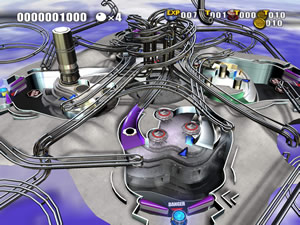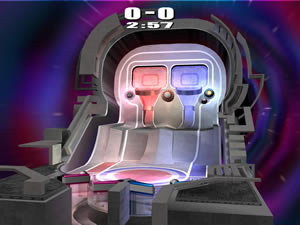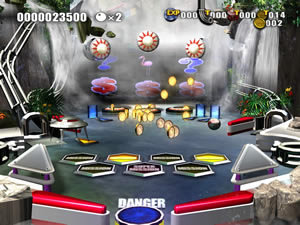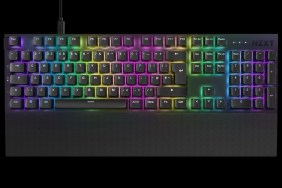Someone grab a plunger.
Pinball is gaming’s cockroach. Having reached its apex as the anchor of arcades in the 1970’s, this once-proud pastime gracefully took a backseat to the home console revolution of the 80’s and 90’s, presumably waiting underneath the technological refrigerator for the television lights to permanently go out, thus ushering in a new age of pinball dominance. Muahahaha!
Well, that doesn’t look to happen anytime soon. We don’t see too many pinball video games these days, and when we do, they’re either awkward recreations that try to emulate the experience perfectly or awkward abominations that try to jazz it up with kooky hi-jinks.
Capcom’s weird Flipnic is the latter, a strange melange of classic pinball and contemporary Japanese nonsensicality. But for all its quirk, this oddity checks itself into a roach motel thanks to tedious, repetitve gameplay.
Flipnic features four esoteric levels: Biology, Metallurgy, Optics and Geometry. Each has a series of tables connected by twisting, turning ramps, and each of these smaller boards has its own flippers, bumpers and goals. One might be the multi-ball screen, while another might contain some shorter timed missions. It’s like one gigantic pinball world to explore rather than just whacking away at drop targets.
Although to be honest, that’s mostly what you do. Whether you’re marveling at the giant iguana staring at you in the Biology level or wowing at the groovy lights in Optics, the name of the game is pinball. You have a button for each flipper (thankfully customizable, as the default scheme is moronic) and buttons to nudge, although this does very little. No power-ups, no ball upgrades " just straightforward pinballin’.
 The game’s main mode challenges players to complete a set of red missions before opening up the next level, with alternate yellow missions adding some extra depth. The concept itself is a good one, as it helps focus your efforts. Unfortunately, it doesn’t work very well. The missions often require you to perform a series of tasks in a specific order; you’ll eventually get stuck on a ramp you have to access, forcing you to make the same unlikely attempt again, and again, and again.
The game’s main mode challenges players to complete a set of red missions before opening up the next level, with alternate yellow missions adding some extra depth. The concept itself is a good one, as it helps focus your efforts. Unfortunately, it doesn’t work very well. The missions often require you to perform a series of tasks in a specific order; you’ll eventually get stuck on a ramp you have to access, forcing you to make the same unlikely attempt again, and again, and again.
This gets particularly aggravating because ramps often send you to other boards. You might accidentally hit the wrong one, fly off to another board, then waste ten minutes trying to hit a ramp to take you back to where you started. Just like the real thing, there is no mid-game save, so if you manage to accomplish three of the red missions before losing your last ball, you’ll have to start from scratch again. This is not the most enjoyable way to play pinball.
Luckily, you can just hop into Free Play at any point, which unlocks all the levels and lets you simply whack through them for high scores. Problem solved? Not quite. Despite the wealth of weird diversionary sub-tables and missions, the core language of any pinball game – hitting ramps and targets repeatedly to rack up points – is lost in translation. Normal pinball tables manage to breathe life into one static board by setting up all kinds of different challenges using the same collection of ramps and targets. There are multiple tables in a Flipnic level, but each ramp only seems to do one thing, like take you to another table or give you some coins. There’s a paucity of useful things to hit, instead just jetting you from sub-table to sub-table without much to do on any of them. Despite its flamboyant approach, the experience is kind of flat.
 The graphics, however, are most certainly not. Flipnic is at once stylish and retro, from its opening cinematic to its bizarre, kitschy way of portraying missions with weird fonts and voices. The worlds are bursting with energy. Biology’s organic theme is conveyed with trees, foliage and plentiful animations, while Optics is all techno-groovy with pulsating lights and smooth, rounded edges. Geometry isn’t pinball at all, replacing the bright look and flippers with a retro feel and paddles as you play a pinball version of Breakout. The ball physics, while not as accurate as what you’ll find in a pinball sim, are good enough to keep you believing you’re playing pinball. The framerate can chug during the more hectic multi-balls, but like the bulk of Flipnic‘s look, it’s usually rock solid.
The graphics, however, are most certainly not. Flipnic is at once stylish and retro, from its opening cinematic to its bizarre, kitschy way of portraying missions with weird fonts and voices. The worlds are bursting with energy. Biology’s organic theme is conveyed with trees, foliage and plentiful animations, while Optics is all techno-groovy with pulsating lights and smooth, rounded edges. Geometry isn’t pinball at all, replacing the bright look and flippers with a retro feel and paddles as you play a pinball version of Breakout. The ball physics, while not as accurate as what you’ll find in a pinball sim, are good enough to keep you believing you’re playing pinball. The framerate can chug during the more hectic multi-balls, but like the bulk of Flipnic‘s look, it’s usually rock solid.
The audio is a little less dependable, as the music alternates between trancy (Optics) and grating (Geometry). The effects are mostly innocuous, but since you wind up hitting the same ramps over and over again, get used to hearing the same sounds.
Flipnic also turns multiplayer pinball on its head by eschewing the typical turn-based play in favor of four two-player games, one for each world. Playing pinball foosball or a pinball hoop-shoot might sound appealing, but none of them are very fun and often have more to do with luck than skill. I played the bumper-driven Optics game against an unmanned, unplugged controller and only won 10-8. Sheesh.
I admire the daring look and crazy design of Flipnic, but the sparse tables and occasionally frustrating missions dull its polish. As its saving grace, the game retails for a reasonable 20 bucks. That’s not bad if you’re interested in a genuinely bizarre, pretty game of pseudo-pinball, although it doesn’t take a pinball wizard to figure out that if you double that price, you can probably find a game four times as entertaining.
-
Cool graphics and loads of style
-
Only 20 bucks
-
To get bored quickly
-
Frustrating mission mode
-
Bad multiplayer











